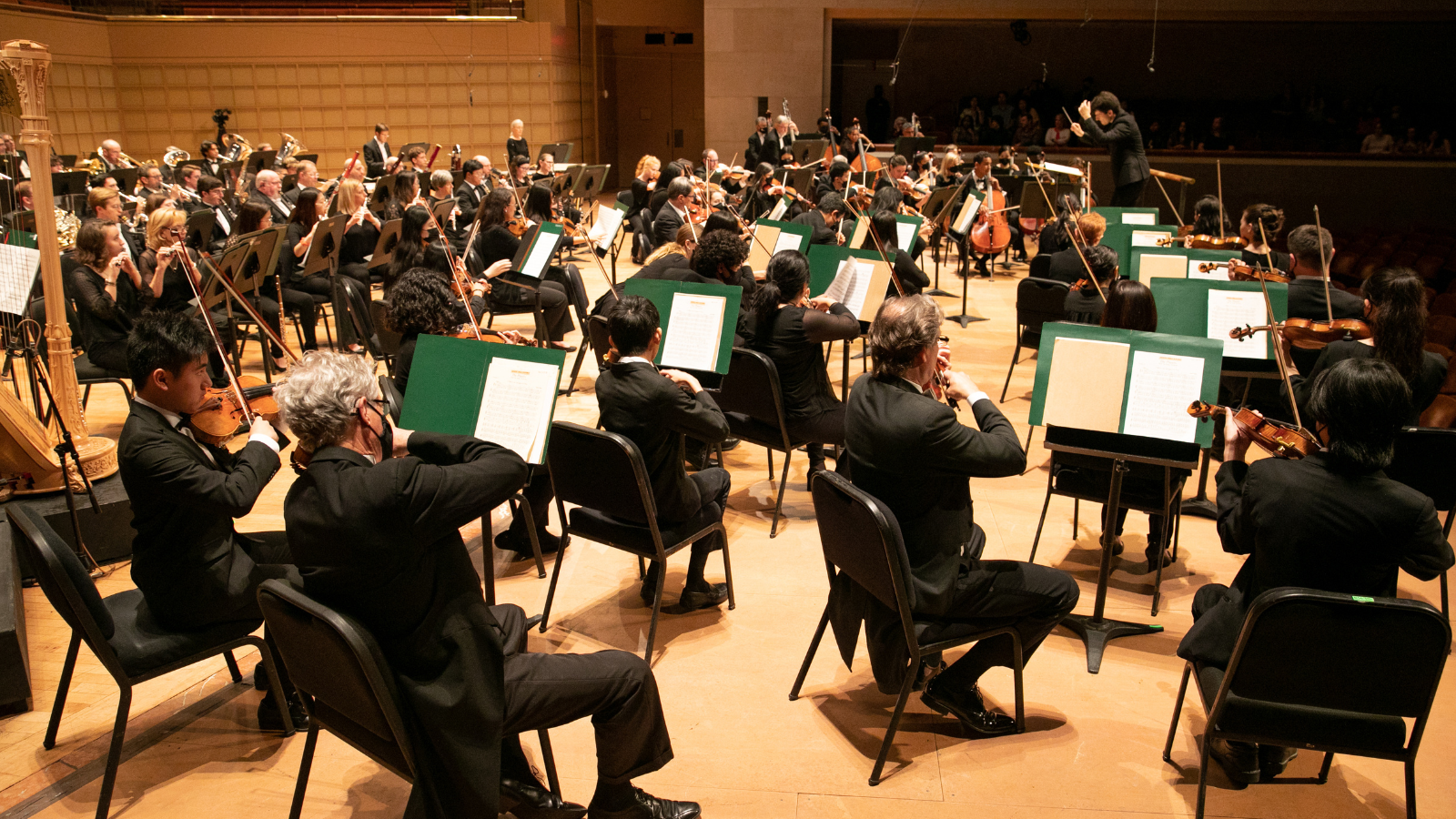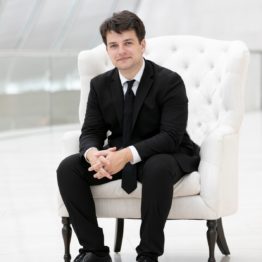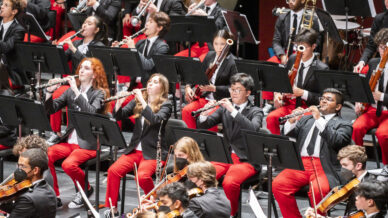

Tchaikovsky Piano Concerto No. 1 | Annual Side-by-Side
junio 9, 2023
MAURICE COHN lleva a cabo
JACK ROUECHE piano | Lynn Harrell Concerto Competition
GRAN ORQUESTA JUVENIL DE DALLAS
ORQUESTA SINFÓNICA DE DALLAS
BOULANGER Of a Spring Morning
TCHAIKOVSKY Concierto para piano nº 1
DEBUSSY Prelude to the Afternoon of Faun
SIBELIUS Karelia Suite
SMETANA Dance of the Comedians
A special one-night-only concert experience, featuring Jack Roueche, the 2023 Lynn Harrell Concerto Competition winner, and a side-by-side performance from the DSO and Greater Dallas Youth Orchestra. Presented with the help of the Dallas Symphony Teen Council, join us an hour before the concert for pre-concert activities including performance preludes and a special photobooth— and after the performance for a post-concert ice cream social.
Notas del programa
por René Spencer Saller
Lili Boulanger was born in Paris, France, in 1893. She was born into a musical family as the daughter of Ernest Boulanger, a conservatory teacher and composer known for his operas, and Raissa Myshetskaya, a Russian princess and vocalist from Saint Petersburg. Even after her father’s passing when she was just three years old, her life continued to revolve around music. Her mother learned harmony in order to teach to her children, who began reading, playing, and composing music at early ages.
Boulanger entered the Paris Conservatoire in 1909 at age 16 where she studied composition under Georges Gaussade and Paul Vidal. Despite her battles with her declining health, she found her own musical personality and composed continuously throughout her short life. She won the Prix Lepaulle after only a year at the Conservatoire and was the first woman to receive the Premier Grand Prix de Rome in music at only 19 years old.
While her health continued to deteriorate, she composed a significant body of vocal and instrumental works that had a great impact on the musical world. She broke new ground for female composers before she died at age 24. “Hers was a creative life of more than mere promise; it was a life, at least, of partial fulfillment.” David Noakes, a musicologist, sang high praises of Boulanger’s work after her death, and Lili’s older sister, Nadia, made it her life’s work to keep her sister’s music alive. Nadia became the 20th century’s most influential teacher and mentor for other composers, yet never considered herself one even given her impact on composers then and now.
D’un Matin de printemps (Of a Spring Morning) was first performed on March 13, 1921 in Paris, France,. This work was one of the last scores written by Boulanger’s own hand. The composer wrote each piece of hers in three versions, one for orchestra, one for piano trio, and a third for violin (occasionally flute) and piano. The score calls for piccolo, two flutes, two oboes, English horn, two clarinets, bass clarinet, two bassoons, contrabassoon, four horns, three trumpets, three trombones, tuba, timpani, cymbals, snare drum, triangle, and the usual strings.
D’un Matin de Printemps (Of a Spring Morning) was completed alongside D’un Soir triste (Of a Sad Evening) in 1918. Both share common ideas for their theme but represent contrasting moods which are implied by their titles. These companion pieces were composed during the last months of her short life.
D’un Soir triste conveys an inconsolable amount of despair, as the piece moves forward, a taste of something brighter is acknowledged in the work’s final moments. D’un Matin de printemps picks up right where this suggestion of hope leaves off bringing in the feeling of dawn breaking. Its opening is flourished with light eighth notes heard in the strings that provide momentum as flute enters with the melody. Similar to French music of this time period, winds prominently featured bringing vibrancy into the piece. The spring morning does not conclude without its own darkness despite its bright opening. Once brass and percussion join the ensemble the energy sinks into a darker, murkier state.
Boulanger employs the allusion of color and texture in the music to continue the battle between two realms. One is portrayed as bright and alert, restating the main theme in the winds as a call to attention with a fast paced tempo. The other is conveyed as dreamlike, marked in the music as mysterieux, meaning mysterious or weird, with ghostly sounds of violin heightening the effect of the theme. As the piece continues, the initial light and springy energy eventually returns in a series of crescendos and the rise of the full ensemble eventually resolves with a glissando on harp.
Ignoring the modern sense of the word, Peter Ilyich Tchaikovsky is best described as bipolar. On the same day, he wrote to a friend that “day by day, I grow more depressed” while later writing to his brother Modest that his successes were so great that “soon [his] fame will crush [Modest]”. He was also known to develop vastly different opinions about his pieces within the span of sometimes just twenty-four hours. His Overture in C minor was a piece that he had been pleased with, but later marked the words ‘Awful rubbish’ on the score. Similarly, Tchaikovsky was ecstatic about the artistry of this Fourth Symphony on the day of the premiere but condemned it the very next day, despite how well it was received by the public.
Tchaikovsky came into his compositional prowess at a time when the “Mighty Five” were dominating the Russian musical scene. The “Mighty Five,” also called the “Mighty Handful,” were a group of five Russian composers. These composers included Rimsky-Korsakov, Mussorgsky, Cui, Borodin, and Balakirev. As a student of Nikolay Rubenstein’s at the St. Petersburg Conservatory, Tchaikovsky’s music was attacked by these five composers. However, Tchaikovsky’s independence from the “Mighty Five” earned him a reputation separate from these other Russian composers and allowed him a competitive place in the Russian music scene.
Nikolay Rubinstein was a relentless teacher. One of Tchaikovsky’s earlier pieces, Overture in C minor, was declared “unsuitable” by his professor. Rubinstein was known for being short tempered, and Tchaikovsky, who was staying with Rubinstein after his graduation from the St. Petersburg Conservatory, was afraid to work late at night for fear that the scratching of his quill would wake his professor. However, Rubinstein’s mentorship had its perks. Through Rubinstein, Tchaikovsky was able to meet many of Russia’s most prominent musicians, and many of these, including the cellist Karl Albrecht and the critic Nikolay Kashkin, would become lifelong friends. According to Tchaikovsky’s brother, Modest, “all Moscow was personified in Rubinstein… of whom it is no exaggeration to say that he was the greatest and most lasting influence on Tchaikovsky’s career. No-one, artist or friend, did so much for the advancement of his fame, gave him greater support or affection, or helped him more to conquer his initial nervousness and timidity.”
Initially, Tchaikovsky was a very nervous person. Unlike many composers who conducted their own works, Tchaikovsky was often unable. He had an irrational fear that his head would fall off while he was conducting and was known to keep one hand on his head and the other on his baton on the rare occasion that he conducted one of his works. During the premiere of his first symphony, a critic wrote that “from the moment Pyotyr Illyich appeared [he] was a nervous wreck… When he finally made it to the podium, he looked like he would rather be anywhere else. He forgot every note of his piece, and failed to give the players cues at all the most crucial moments. Luckily, the orchestra knew the piece so well that they took no notice of their inept conductor and all his incorrect instructions. They performed the piece perfectly well, occasionally looking up at the composer with big grins on their faces”. Fortunately, the symphony was well received, and Tchaikovsky vowed to never conduct again.
Una escucha más atenta
Just like Tchaikovsky’s Overture in C minor, Rubinstein initially thought Tchaikovsky’s First Piano Concerto was “worthless and unplayable.” Tchaikovsky was hoping Rubinstein would agree to perform the premiere, but Rubinstein refused unless large revisions were made to the piece. Tchaikovsky, unwilling to make these edits, took the piece to pianist Hans von Bülow, who agreed to give the premiere. On October 25, 1875, Tchaikovsky’s First Piano Concerto was performed in Boston during Bülow’s American tour. The piece was received very well there, and it was a huge success for Tchaikovsky. The Piano Concerto eventually gained the same success in Europe, and Rubinstein even agreed to conduct the work.
Tchaikovsky’s First Piano Concerto opens with a grandiose descending line in the horns, followed by fortissimo orchestral hits. Then the piano enters with massive chords as the strings take up a sweeping and majestic melody. Unlike most pieces, this famous melody only gets repeated once more, before disappearing from the rest of the concerto. The opening melody is based off a Ukrainian folk song that Tchaikovsky heard while on the streets in Kiev. The grand, expansive first movement is the most well-known and memorable movement of the concerto. The second movement is lighter and slower than the first. Marked andantino semplice, this movement is simple and beautiful. The section starts with pizzicato in the strings, then a melody is taken up the solo flute. The piano comes in, and with it, the bassoon. The strings also switch back to normal bowing. In this part of the concerto, the elegance and delicacy that is present in Tchaikovsky’s ballet music shines through, and a different side of Tchaikovsky is heard.
The third movement, written in rondo form, is fast and virtuosic. The rondo form is a form characterized by the appearance and reappearance of an initial melody. This movement also includes quite a bit of playoff and conversation between the soloist and orchestra. The orchestra passes an introduction around among sections, and the piano quickly takes up and develops this melody. The piano finishes the melody, and the orchestra quickly reintroduces it. The piece ends with conversation between the piano and orchestra, climaxing in a fortissimo long note held by the musicians.
Since its premiere, Tchaikovsky’s First Piano Concerto has commanded the adoration of audiences. It’s a good thing Tchaikovsky didn’t allow Rubinstein’s initial criticisms to deter him. There is something to be said about Tchaikovsky’s refusal to make Rubinstein’s revisions. Perhaps musical honesty is more important than the approval of your superiors.
Claude Achille Debussy (1862-1918) was a French impressionist composer who had a great love for art of many kinds. From painters to poets, Debussy’s closest friends were not composers, but other types of artists. In fact, Debussy regarded most of his compositional colleagues with contempt. Massanet displayed “an extraordinary talent for satisfying all that is poetically empty and lyrically cheap,” Stravinsky was “a spoiled child… who wears noisy ties and kisses ladies’ hands while treading on their toes,” and Fauré was no better than a “musical servant of a group of snobs and imbeciles.”
Debussy often felt that music was misunderstood by his colleagues and the general public. In a letter to André Poniatowski, a patron of his, Debussy disclosed that his great ambition was to “run [his] own show in [his] own way and root out the imbecility in musical understanding that [the] last few years [had] fostered in the gentle listeners of [his] time.” He condemned artists for sucking up to the general public instead of making honest art. Debussy believed that composers “should write music that contains the whole of [their] life, not just a little bit of it made attractive only by an elegant setting and by the idle conversation of those who don’t compose.”
The attitude of the public towards what Debussy considered honest art and the lack of appreciation of his early music pulled Debussy into a nearly constant depression. After winning the Prix de Rome in 1884, he set out for the Villa Medici. However, he found himself so unhappy because of the beliefs and ideas of his fellow artists that he ended up leaving after only a few months. Debussy struggled all his life to change the culture of music in Paris. He often felt imprisoned by the public. He needed to make a living from his music, yet many didn’t find his music as beautiful or harmonically pleasing as the other leading composers of Debussy’s time. Though he longed to change the Paris culture, Debussy was forced to, at times, write music that pleased the public, even if it contrasted with his ideals. However, Debussy was able to find pride in his work, and his depressions were punctuated by occasional bursts of happiness. The composer was truly pleased with his Ibéria and found real joy in the immaterial nature and improvisation-like quality of the piece. Similar textures can be found in Preludio de la tarde de un fauno, which he composed years earlier.
Una escucha más atenta
Stéphane Mallermé’s Faune tells the story of Pan, the Greek satyr or faun who is half man and half goat. Pan pursues Syrinx, a nymph and his love, who has metamorphosed into reeds. Pan, distraught after the loss of Syrinx, plays beautiful and mournful music on his flute. Mallarmé’s poem is perfect for a composer like Debussy, self-proclaimed as someone “too prone to dream [his] life away and to see realities only at the moment they become insuperable”. The poem moves back and forth between dream and wakefulness, past and present, and flute music and story. After months without artistic inspiration, Debussy was ecstatic to finally find Mallarmé’s poem, which he believed was equal to his artistic talents. Debussy scrambled to attain permission to set the poem to music, which Mallarmé was happy to grant him. Mallarmé writes:
No stream goes but that my flute is pouring, Over assent-sprayed groves; the solo breeze- Agile from my double pipe – it is eased:To shower down the sound in arid rain And then, on the unrippled world-plane,Be breath – visible, serene, man-sent – Of inspiration, lodged in firmament.
Naturally, Debussy starts his Faun with a flute solo, now one of the most famous flute solos in orchestral repertoire. The orchestration then opens up, and harp, horn and strings can be heard. Preludio de la tarde de un fauno is essentially written in three parts: The first part is defined by that main flute melody passed between different instruments, the second by the absence of that melody, and the third by the reemergence of the beginning melody. Debussy piece is a constant battle between the keys of C sharp and E to achieve dominance. The key of C sharp, presented first in the flute solo, represents Mallarmé’s Faune, and the key of E represents the Afternoon and the Fate that took Syrinx away. As in Mallarmé’s poem, Debussy attempts to capture the sense of a memory placed just out of reach. Using this conflict of keys and various unconventional harmonies, Debussy is the only composer who has been able to successfully transfer Mallarmé’s twisting dreamscape into music.
Habla el compositor
It was very important to Debussy that he accurately represented Mallarmé’s Faune. In Debussy’s words, “if the music were to follow [the poem] more closely it would run out of breath, like a dray-horse competing for the Grand Prix with a thoroughbred.” For all his criticisms of other composers, Debussy was careful to practice what he preached. He stayed far away from a “constructional knowhow” which was “a burden upon [the] finest intellects.” What the listener hears in the piece is exactly what Debussy proclaims: “It has no respect for tonality!” Instead, it’s written in “a mode which is intended to contain all the nuances. All the same it follows the ascending shape of the poem as well as the scenery so marvelously described in the text, together with the humanity brought to it by thirty-two violinists who have got up too early! As for the ending, it’s a prolongation of the last line: ‘Couple farewell, I go to see what you became.’” And indeed, Faun became. The beauties of Preludio de la tarde de un fauno have lasted for decades. The dream-like nature of the piece and the image of a fragmented memory have resonated with people since its premier. It’s no wonder that this masterpiece has stood the test of time.
Jean Sibelius was a Finnish composer and national icon. He was always fascinated with Finnish culture, especially a Finnish mythological text, the Kalevala. Most of Sibelius’s music was written about Finland, and his nationalistic style came during a time when Finland was in the process of gaining independence from Russia. During this time, the Finnish public connected greatly with his music, and his Finlandia even became Finland’s unofficial anthem. Sibelius was so well respected that the state gave him an annual sum of money so that monetary worries wouldn’t impede his composition, and his image even appeared on the Finnish one-hundred mark bill.
All his life, Sibelius felt a strong connection to nature, and he uses nature as a guide for many of his pieces. He wrote quite a few pieces about the Finnish countryside, including Höstkväll (Autumn Evening) y På verandan vid havet (On a Balcony by the Sea). Even his very first surviving work, Vattendroppar (Water Drops), was related to nature. As a young child, Sibelius would wander in the woods improvising on the violin, and later in life, he kept a journal filled with notes on nature’s beauty. Sibelius had an especially strong interest in migrating birds like swans and cranes, even saying that, “Millions of years ago, in my previous incarnations, I must have been related to swans.”
Sibelius was a very critical composer. After publishing his Fifth Symphony, he retracted it twice for edits. Only after the second time did he feel it was fit for a true publishing. Sibelius spent so long revising his Fifth Symphony that its completion overlapped with the Sixth and Seventh symphonies, and in a letter, he wrote that “it looks as if I may come out with all three symphonies at the same time.” Near the end of his compositional career, Sibelius actually burned several of his manuscripts. Among these was his unfinished Eighth Symphony, which was never published, and the original manuscript for the Karelia Suite. However, the Karelia Suite was eventually reconstructed from the surviving orchestral parts, and it has been a concert favorite ever since.
Una escucha más atenta
Karelia is a Finnish province and a center for Finnish culture. The province is a source of much of the material in the Kalevala, and Karelianism, a Finnish nationalist movement, came from this region. Karelianism was a movement Sibelius identified closely with throughout his life. Karelia was composed for the Viipuri Students’ Association for a historical tableau at the Helsinki University in Vyborg. Because of the piece’s strong nationalistic meaning, Karelia was received very well at its premiere. In one of his letters, Sibelius stated that “you couldn’t hear a single note of the music – everyone was on their feet cheering and clapping.” However, it’s worth noting that the original Karelia was revised by the composer and adapted into the Karelia Suite.
El Karelia Suite was written in three movements, and each depicts an element of Finnish culture. The first movement opens with strings, which set the groundwork for soft horn calls. The horns extend their original phrase, and the movement takes on a more grandiose tone. This movement is meant to portray a procession of Karelians paying taxes to an oppressive duke in Lithuania. The second movement is more introspective, with an English horn solo representing the voice of a bard. This movement captures the reflective melancholy Karl Knutsson, a king, feels while listening to his bard’s song. The third movement was written as a march, and its grand and majestic atmosphere makes it a common choice as a stand-alone piece. Brass fanfare and piccolo can be heard playing a victorious theme. The original tableau depicted the destruction of a city, however, this movement was rewritten by Sibelius to be bright and spirited. The piece closes with a portion of the Finnish national anthem.
Sibelius always made sure to craft each phrase with care. The composer gave the advice to “never write a superfluous note; every note must live.” This was a motto Sibelius carried with him for his whole life, and it’s why he was known to burn manuscripts. Sibelius gives a challenge to us all: never say a wasted word, never throw away a moment, and never allow yourself to give anything less than your best.
Bedřich Smetana was a Czech composer who was regarded as the father of Czech music in his homeland for pioneering the development of a musical style that was closely identifiable within his people’s aspirations and cultures.
He is best known for his 1866 opera La novia de trueque which portrays the history, legends, and landscapes of the composer’s native Bohemia.
Smetana was a naturally gifted composer and gave his first public performance at the age of six. After conventional schooling, he traveled to Prague where he studied under Josef Proksch.
He left Prague briefly to travel to Sweden where he taught and began to write some of his large-scale orchestral works only to return to Prague permanently in the 1860’s.
His first two operas The Brandenburgers in Bohemia y La novia de trueque were premiered at the new Provisional Theatre, the latter of the pieces achieving great popularity. Smetana quickly became the theater’s principal conductor until controversy due to his identification with progressive ideas of Franz Liszt and Richard Wagner interfered with his creative work and precipitated his resignation from the theater in 1874.
Even after becoming completely deaf in 1874, he managed to sustain a period of composition that continued throughout most of his life. His contributions to Czech music and culture were continuously recognized and honored even after his passing.
Smetana experienced a mental collapse in 1884 that led to his confinement in an asylum and his death followed soon after. His reputation as the founding father of Czech music has remained in his native country due to the advocacy of his status from his successors. However, few of his works are in the international repertory and most foreign musicians regard Antonín Dvořák as a more significant Czech composer.
La novia de trueque, where “Dance of the Comedians” originates, is a comic opera composed in three acts and first performed on May 30, 1866.
This piece conveys the story of a small country town filled with excitement over a traveling circus coming to town. The comedians are putting in an effort to get patrons to come to their show by introducing other performers. This includes acrobats, clowns, a dancing bear, and a beautiful dancer named Esmeralda who dons fancy costumes throughout her performance.
The music is a fast-paced Slavic dance known as a skocna that uses all of the instruments in the orchestra including strings, woodwinds, trumpets, and especially drums.
Smetana creates different musical sections for the ballerinas, acrobats, clowns, and each act to differentiate their performances. As the circus music stops, the story represents the dancing bear breaking free as everyone screams and runs for cover. Instead of chasing the audience members, the bear lifts its head up to reveal that it’s actually a young village boy who dreams of running away and joining the circus!
“Dance of the Comedians” begins with the accent of a timpani as the strings run a melody of fast-paced eighth notes. Accented rhythms can be heard in the percussion section as this run continues until a new melody is picked up representing the excitement and anticipation of the circus. The strings and woodwinds trade off the role of the melody throughout the middle of the piece as it lulls down to a quieter and calmer tune that quickly crescendos and fades again throughout the ensemble. A ritardando, or slow down, in the orchestra can be heard before the strings establish a new but similar melody of running notes. Percussion continues to accentuate the music as the circus act continues.
The melody gradually slows down as the piece crescendos before descending back down into a quieter section welcoming a brief pause followed by yet another set of eighth-note runs in the strings that fluctuate in volume.
The piece quickly changes into a new format showcasing a more elegant dance starting off in the winds before the strings take the melody. The ensemble repeats the most prominent melody heard throughout the piece as the violins finish their last run, signifying the end of the piece.



